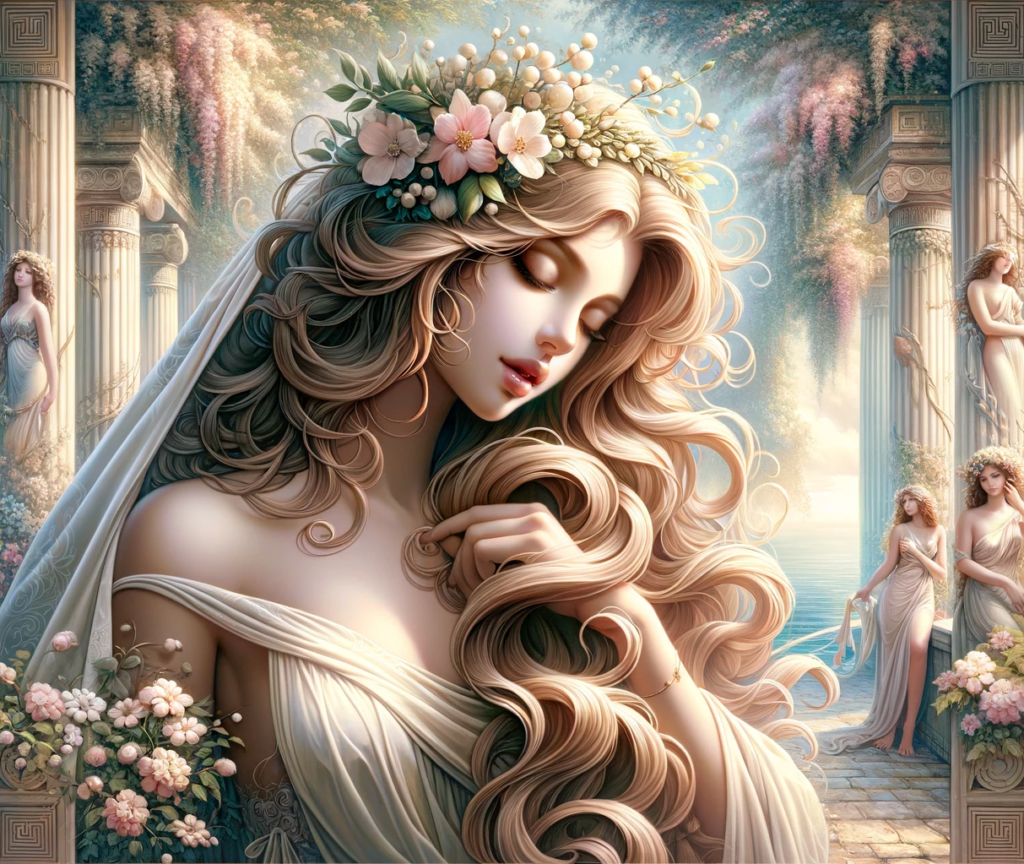Greek Goddess of Love, Beauty & Desire (Pleasure)
Aphrodite, the Greek goddess of love, beauty, and desire, stands as one of the most captivating and influential deities in ancient Greek mythology. Her origins though, are shrouded in mystery.
According to Hesiod’s Theogony, she emerged from the sea foam in the waters of Paphos, on the island of Cyprus, born from the severed genitals of Uranus. She supposedly arose from the foam when the Titan Cronus slew his father Uranus and threw his genitals into the sea.
However, according to Homer, in Iliad, Aphrodite may instead be the daughter of Zeus and Dione. As with so many Greek deities, there are many stories about the origins of the gods.

Beauty Beyond Comparison
Many gods believed that her beauty was such that their rivalry over her would spark a war of the gods. Because of this, Zeus married Aphrodite to Hephaestus the god of craftsmanship. He wasn’t seen as a threat because of his ugliness and deformity.
Despite this marriage to Hephaestus, Aphrodite had many lovers. Her lovers include both gods and men – including the god Ares and the mortal Anchises. She also played a role in the story of Eros and Psyche in which admirers of Psyche neglected to worship Venus (Aphrodite) and instead worshipped her. For this, Aphrodite enlisted Eros (Cupid) to exact her revenge but the god of love instead falls in love with the girl.
Later, Aphrodite was both Adonis’s lover and his surrogate mother. This led to a feud with Persephone in which Zeus decreed Adonis should spend half of the year with Aphrodite and half of the year with Persephone.
Aphrodite’s Children
Across the various myths and legends, Aphrodite had at least 16 children, with many different partners. Here’s a selection of some of the most notable.
Eros (Cupid)
Born from Aphrodite’s union with Ares, Eros (also known later by the Romans as Cupid), is the god of love and desire. Often depicted as a mischievous, winged child, Eros wields a bow and arrows, which he uses on both gods and mortals. When struck by his arrows, Eros could control the emotions of his targets, leading to various romantic entanglements and conflicts in Greek myths.
Phobos
Phobos, whose name means ‘fear,’ is the personification of terror and panic. He is the offspring of Aphrodite and Ares. In mythology, Phobos is often depicted accompanying his father into battle, instilling fear and dread in the hearts of warriors. His presence on the battlefield underscores the psychological aspects of war, beyond mere physical confrontation.
Deimos
Deimos, the twin brother of Phobos and another son of Aphrodite and Ares, embodies the terror of dread. His role in mythology is similar to that of Phobos, often accompanying Ares in war and spreading fear among soldiers. Deimos represents the paralyzing fear that can grip individuals in the face of impending danger or conflict.
Harmonia
Harmonia, born to Aphrodite and Ares, is the goddess of harmony and concord. In stark contrast to her brothers, her role in mythology is to create balance and peace, often symbolizing the harmonious union of opposites. She is famously known for her unhappy marriage to Cadmus, the founder of Thebes, which was marked by tragedy and transformation.
Anteros
Anteros is often considered the avenger of unrequited love and the punisher of those who scorn or do not return love. His role in mythology is less clear than that of Eros, but he is sometimes depicted as Eros’ counterpart or even his brother.
Hermaphroditus
Hermaphroditus, the child of Aphrodite and Hermes, is unique in Greek mythology. Born a remarkably handsome boy, he was transformed into an androgynous being when the nymph Salmacis merged with him.
Rhodos
Rhodos, a daughter of Aphrodite and Poseidon, is associated with the island of Rhodes. She is not as prominent in mythology as some of Aphrodite’s other children, but she represents the embodiment of the island itself.
Aeneas
Perhaps one of the most famous of Aphrodite’s children, Aeneas, born from her affair with the mortal Anchises, is a hero of both Greek and Roman mythology. He is best known for his role in Virgil’s ‘Aeneid,’ where he becomes a symbol of Roman ideals and destiny. Aeneas’ journey from Troy to founding what would become Rome intertwines the fates of Greece and Rome.
And The Rest…
- Pothos: God of longing or yearning, often associated with unfulfilled love. Child of Aphrodite, possibly with Ares or Dionysus.
- Himeros: God of desire and unrequited love, closely linked to Eros. Son of Aphrodite, father often unspecified.
- Eryx: A king or hero rather than a deity, associated with a region in Sicily. Son of Aphrodite and Poseidon.
- Peitho: Goddess of persuasion and seduction, important in romance and rhetoric. Daughter of Aphrodite, father not commonly specified.
- The Graces (Charites): Goddesses symbolizing charm, beauty, and creativity. Daughters of Aphrodite, often with Zeus as their father.
- Beroe: Named after the city of Beroea, her mythological role is less defined. Daughter of Aphrodite and Adonis.
- Golgos: Associated with the city of Golgi, not extensively featured in myths. Parentage typically includes Aphrodite, father not clearly identified.
- Priapus: A rustic fertility god, known for his large phallus. Son of Aphrodite, often with Dionysus as his father.
Learn more about this family line in our post about the many children of Aphrodite!

Symbols and Sacred Items
Many of the symbols associated with Aphrodite underscore her dominion over love and beauty. The rose, for example, is emblematic of passion and romance. The myrtle, represents love and immortality, while the apple is a symbol of desire. Each of these symbols are intimately linked to her.
Other important items that have deep symbolism with Aphrodite include the seashell, reflecting her birth from the sea, and the mirror, signifying beauty and vanity. Both are potent symbols of her influence.
Sacred Animals
The animals sacred to Aphrodite further symbolize aspects of her nature. The dove, representing peace and love, the sparrow, a symbol of amorousness, and the swan, embodying grace and beauty, are often depicted alongside her. These creatures not only signify her dominion over love and beauty but also serve as her celestial messengers.
Myths Surrounding Aphrodite
The Judgement of Paris and the Trojan War
Aphrodite had a large role in the events leading to the Trojan War, through the Judgement of Paris. She was one of the three goddesses, along with Hera and Athena, who claimed the golden apple inscribed “To the fairest.” They asked Zeus to judge the contest, but he refused. Paris, son of the King of Troy, judged the contest instead. Each of the three goddesses promised him something in return; Aphrodite promised him the love of the most beautiful woman in the world, Helen of Sparta. He chose Aphrodite as the winner of the apple.
This story of the Judgment of Paris was considered to be the real reason behind the Trojan War. Once the war was underway, she fought on the side of Paris. Aphrodite rescued Paris from Menelaus by enveloping him in a cloud and taking him back to Troy. She then further played an important role in protecting her son Aeneas, to the point of intervening directly on the battlefield.
Aphrodite and Adonis
The myth of Aphrodite and Adonis is one of love and tragedy. Adonis, a mortal of great beauty, attracted Aphrodite’s love. She saw him when he was born and determined then that he should be hers. She assigned Persephone to his care, but Persephone fell in love with Adonis also and would not give him back. Finally, Zeus had to mediate. He judged that Adonis should spend half the year with each.
However, he was fatally gored by a wild boar, leading to his death. Aphrodite was overcome with grief, and from Adonis’ blood sprang the anemone flower, symbolizing the fleeting nature of beauty and life.
Aphrodite and Anchises
Aphrodite’s affair with the mortal Anchises, a prince of Troy, is another important myth surrounding the beautiful deity. Disguised as a mortal woman, Aphrodite seduced Anchises and from their union, Aeneas was born, who would later become a hero of the Trojan War and the legendary ancestor of the Romans. This myth links Aphrodite to the epic narratives of both Greek and Roman mythology.
Trials of Psyche
The story of Aphrodite and Psyche revolves around the trials of Psyche to win her over and reunite with her lover Eros, Aphrodite’s son. This tale is rich in symbolism. Exploring themes of love’s trials, transformation, and the relationship between the mortal and the divine.
Facts about Aphrodite
- Aphrodite was the goddess of fertility, love, and beauty.
- Aphrodite was married to Hephaestus, but she did not enter into this union of her own volition.
- She and Ares conceived Harmonia, who eventually married Herodotus.
- She was the mother of Hermaphroditus by Hermes.
- Dinlas was another of her children, who she mothered with Ares. Dinlas was a chaotic God who was sent to Hades by his parents.
- Aphrodite and her son Eros (Cupid) teamed up to cause Zeus to fall in love with a human named Europa.
- Aphrodite used a swan-drawn car to glide easily through the air.
- Although Aphrodite and Hera were not friends, Hera went to the Goddess of Love for help as she endeavored to assist the heroes in their Quest of the Golden Fleece.
- Aphrodite owned a girdle that contained her enchantments; Hera borrowed it once to seduce Zeus in order to distract him from the Trojan War.
- Aphrodite gave Harmonia a necklace that brought disaster to a later generation.
- Prostitutes considered the Goddess of Love their patron.
- Corinth was the center of Aphrodite’s worship.
- Early Greek art depicted the goddess as nude.
- She was the model for the famous sculpture Venus de Milo.
- Aphrodite and Eros initiated the love between Jason (hero of the Quest of the Golden Fleece) and the daughter of the Colchian King.
Link/cite this page
If you use any of the content on this page in your own work, please use the code below to cite this page as the source of the content.
Link will appear as Aphrodite: https://greekgodsandgoddesses.net - Greek Gods & Goddesses, September 19, 2014